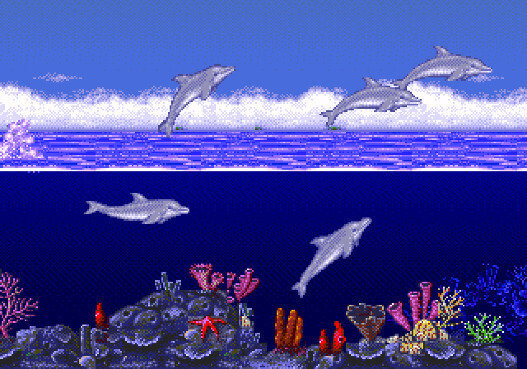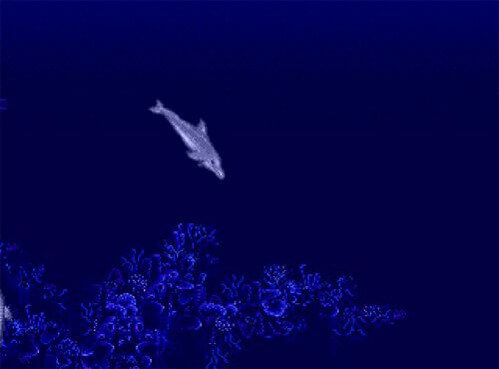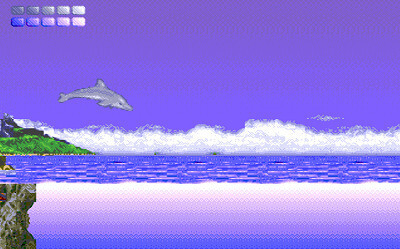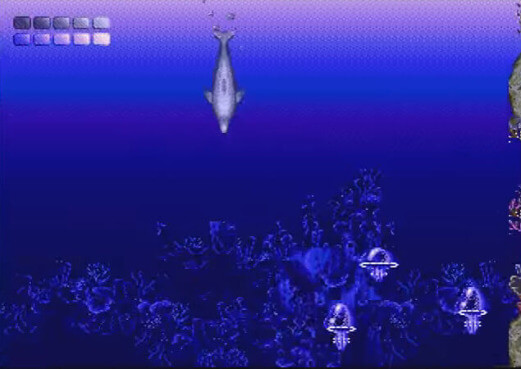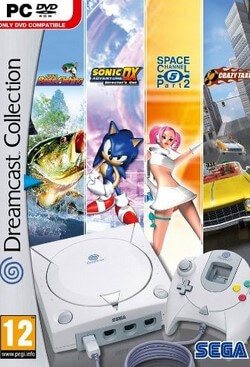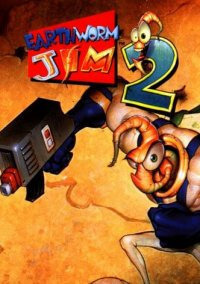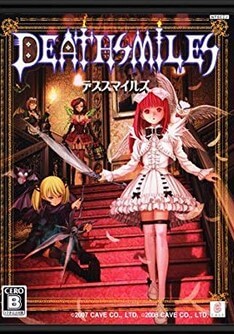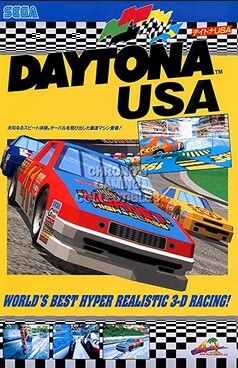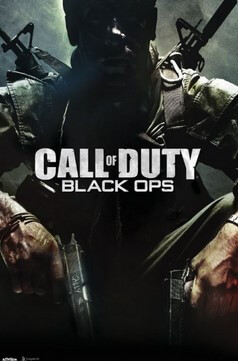Ecco the Dolphin is an action-adventure game originally developed by Ed Annunziata and Novotrade International for the Sega Genesis known as the Mega Drive in regions outside of North America and published by Sega in 1992. Ecco the Dolphin was republished digitally via Nintendo's Virtual Console in 2006, Microsoft's Xbox Live Arcade, Steam, iOS, and Nintendo 3DS.
It is the first installment in the Ecco the Dolphin video game franchise. The player character is a bottlenose dolphin who travels through time to combat hostile extraterrestrials in Earth's oceans and on an alien spacecraft.
Gameplay
Attacking enemies is accomplished by making Ecco ram into them at high speeds. Swimming can be made progressively faster by tapping a certain button, and the speed can be maintained by holding it down. Players can perform a purely aesthetic spin in the air when jumping out of the water.
Two features of the game play on actual dolphin habits: one button causes Ecco to sing, allowing him to speak with other cetaceans and interact with certain objects. The same button is used for echolocation: holding it down causes the song to return, generating a map of the area. Several levels contain enormous crystals called glyphs, which respond in different ways if Ecco touches or sings to them. Some block paths, and a "Key-Glyph" must be found in such cases to pass. Others give information, and a few in later levels replenish health/air and give Ecco temporary invulnerability.
Additionally, Ecco, being a mammal, must surface periodically for air, or else find an air vent. If the "air meter" runs out, Ecco loses health rapidly, which represents drowning. His health is measured by a separate meter (above the air meter); it is depleted by enemies or when his air meter runs out, and it is recharged by eating fish, "singing" to clams, or, later in the game, singing to special statues or crystals called "glyphs". Ecco's song can be optionally upgraded at two points in the game: one upgrade allows Ecco's song to be used in combination with a charge as a long-range weapon, and the other temporarily disorients sharks and makes minor enemies freeze temporarily. Touching any enemy by any means other than an attack causes Ecco to sustain damage. The enemies range from seahorses to giant octopodes.
The penultimate level of the game is titled "Welcome to the Machine", named after "Welcome to the Machine", a song on Pink Floyd's 1975 studio album Wish You Were Here. Ecco: The Tides of Time (1994) features a level called "New Machine", named after "A New Machine", a two-part song on Pink Floyd's 1987 album A Momentary Lapse of Reason.
Plot
The game begins with Ecco, a bottlenose dolphin, as he and his pod are swimming in their home bay. One podmate challenges him to see how high into the air he can jump. When he is in the air, a waterspout forms and sucks up all marine life in the bay except Ecco, leaving him alone in the bay. Upon leaving the bay to search for his pod, he contacts several dolphins from other pods, who tell him the entire sea is in chaos, and that all marine creatures felt the storm. An orca tells Ecco to travel to the Arctic to find a blue whale named the "Big Blue", revered among marine mammals for its age and wisdom. Once Ecco finds him, the Big Blue tells him such storms have been occurring every 500 years and directs him to the Asterite, the oldest creature on Earth. He leaves the Arctic and travels to a deep cavern where he finds the Asterite. Although it has the power to aid him, one of its globes is missing, and needs it returned. However, this can only be achieved by traveling back in time using a machine built by the ancient Atlanteans.
Ecco travels to the sunken city of Atlantis, where he discovers the time machine and an ancient library. He learns the cause of the storm; it was a harvest of Earth's waters that was conducted every 500 years by an alien species known as the Vortex. The Vortex had lost their ability to make their own food, and so every 500 years, they would harvest from the waters of Earth. Learning this, he activates the time machine and travels 55 million years into Earth's past. While Ecco is in the past he learns an ancient song to communicate with a Pteranodon. Ecco locates the Asterite in the past but is immediately attacked by it. Forced into battle, he manages to dislodge a globe from it. This opens a time portal and he is sent back into the present. After receiving the globe, the Asterite grants him the power to turn his sonar into a deadly weapon against the Vortex, as well as the abilities to breathe underwater and to slowly regenerate lost health. The Asterite instructs him to use the time machine to travel back in time to the hour of the harvest. This time he manages to be sucked into the waterspout with his pod. Once inside the waterspout, Ecco makes his way towards the Vortex Queen, the leader of the Vortex race. Ecco destroys the Vortex Queen and his pod returns home.
Development
The existence of Ecco the Dolphin had been heavily rumored throughout the industry before it was finally revealed by Sega in 1992 as a Genesis exclusive, then simply known as Dolphin. After deciding to create a game based around dolphins, developer Ed Annunziata carried out research on the subject and was particularly inspired by the book Sounding by Hank Searls which explained how the creatures use echolocation. Annunziata worked with the music team on the soundtrack, playing them songs by Pink Floyd to illustrate the feeling he was aiming for. Annunziata later said, "I was paranoid about game rentals and kids beating the game over the weekend. So.. I.. uh... made it hard." His favourite level was Welcome to the Machine, which was "way over the top challenging"
The name Ecco comes from John C. Lilly, where, during his experiments with psychoactive drugs, he claims to have met a series of cosmic entities dubbed Earth Coincidence Control Office (E.C.C.O.). In his life, Lilly was involved in extensive research involving dolphins, compiling his work's findings in the book The Mind of the Dolphin. The game takes much inspiration from Lilly's work with dolphins and his experiments with psychedelic substances. Ed Annunziata himself has stated on his Facebook page: "I did read a lot from John C Lilly."






